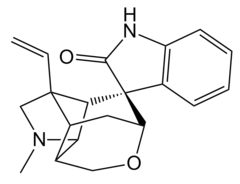Gelsemine

Gelsemine (gelsemin), an indole alkaloid
|
|
| Clinical data | |
|---|---|
| ATC code |
|
| Identifiers | |
|
|
| CAS Number | |
| PubChem CID | |
| ECHA InfoCard | 100.007.360 |
| Chemical and physical data | |
| Formula | C20H22N2O2 |
| Molar mass | 322.40 g/mol |
| 3D model (Jmol) | |
|
|
Gelsemine (C20H22N2O2) is an indole alkaloid isolated from flowering plants of the genus Gelsemium, a plant native to the subtropical and tropical Americas, and southeast Asia, and is a highly toxic compound that acts as a paralytic, exposure to which can result in death. It has generally potent activity as an agonist of the mammalian glycine receptor, the activation of which leads to an inhibitory postsynaptic potential in neurons following chloride ion influx, and systemically, to muscle relaxation of varying intensity and deleterious effect. Despite its danger and toxicity, recent pharmacological research has suggested that the biological activities of this compound may offer opportunities for developing treatments related to xenobiotic- or diet-induced oxidative stress, and of anxiety and other conditions, with ongoing research including attempts to identify safer derivatives and analogs to make use of gelsemine's beneficial effects.
Gelsemine is found in, and can be isolated from, the subtropical to tropical flowering plant genus Gelsemium, family Loganiaceae, which as of 2014 included five species, where G. sempervirens Ait., the type species, is prevalent in the Americas and G. elegans Benth. in China and East Asia, The species in the Americas, G. sempervirans, has a number of common names that include yellow or Carolina jasmine (or jessamine), gelsemium, evening trumpetflower, and woodbine. The plant genus is native to the subtropical and tropical Americas, e.g., in Mexico, Honduras, Guatemala, and Belize, as well as to China and southeast Asia. The species is prized for its "heavily fragrant yellow flowers," and has been cultivated since mid-seventeenth century (in Europe). It is found in many states of the U.S. (e.g., South Carolina), and as a garden plant in warmer areas where it can be trained to grow over arbors or to cover walls (see image above).
All plant parts of the herbage and exudates of this genus, including its sap and nectar, appear to contain gelsemine and related compounds, as well as a wide variety of further alkaloids and other natural products. The plant's herbage, in particular, is known to contain several toxic alkaloids, and is generally known to be poisonous to livestock and humans.
...
Wikipedia
